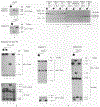The frequency of uniparental disomy in Prader-Willi syndrome. Implications for molecular diagnosis
- PMID: 1584261
- PMCID: PMC7556354
- DOI: 10.1056/NEJM199206113262404
The frequency of uniparental disomy in Prader-Willi syndrome. Implications for molecular diagnosis
Abstract
Background: Prader-Willi syndrome is a genetic disorder characterized by infantile hypotonia, obesity, hypogonadism, and mental retardation, but it is difficult to diagnose clinically in infants and young children. In about two thirds of patients, a cytogenetically visible deletion can be detected in the paternally derived chromosome 15 (15q11q13). Recently, patients with Prader-Willi syndrome have been described who do not have the cytogenetic deletion but instead have two copies of the 15q11q13 region that are inherited from the mother (with none inherited from the father). This unusual form of inheritance is known as maternal uniparental disomy. Using molecular genetic techniques, we sought to determine the frequency of uniparental disomy in Prader-Willi syndrome.
Methods: We performed molecular analyses using DNA markers within 15q11q13 and elsewhere on chromosome 15 in 30 patients with Prader-Willi syndrome who had no cytogenetically visible deletion. We also studied their parents. Three patients with Prader-Willi syndrome who had a cytogenetic deletion served as controls.
Results: In 18 of the 30 patients without a cytogenetic deletion (60 percent), we demonstrated the presence of maternal uniparental disomy for chromosome 15 and its association with advanced maternal age. In another eight patients (27 percent), we identified large molecular deletions. The remaining four patients (13 percent) had evidence of normal biparental inheritance for chromosome 15; three of these patients were the only ones in the study who had some atypical clinical features.
Conclusions: In about 20 percent of all cases, Prader-Willi syndrome results from the inheritance of both copies of chromosome 15 from the mother (maternal uniparental disomy). With the combined use of cytogenetic and molecular techniques, the genetic basis of Prader-Willi syndrome can be identified in up to 95 percent of patients.
Figures



References
-
- Cassidy SB. Prader-Willi syndrome. Curr Probl Pediatr 1984;14:1–55. - PubMed
-
- Greenberg F, Elder FFB, Ledbetter DH. Neonatal diagnosis of Prader-Willi syndrome and its implications. Am J Med Genet 1987;28:845–56. - PubMed
-
- Aughton DJ, Cassidy SB. Physical features of Prader-Willi syndrome in neonates. Am J Dis Child 1990;144:1251–4. - PubMed
Publication types
MeSH terms
Substances
Grants and funding
LinkOut - more resources
Full Text Sources
Medical
